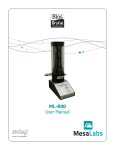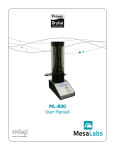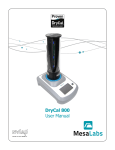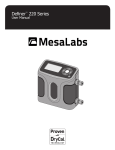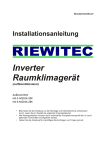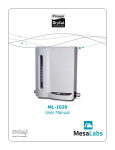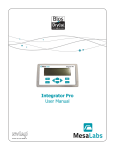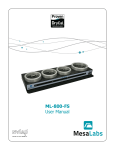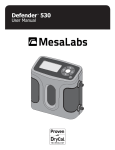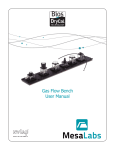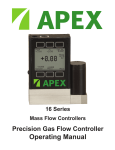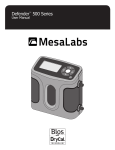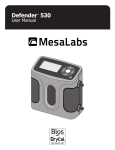Download ML-500 User Manual - DryCal
Transcript
Proven ML-500 User Manual Mesa Labs’ Commitment As a manufacturer of critical equipment, quality is the highest priority in our manufacturing process. Mesa Labs commits to providing creative, innovative thinking and the engineering and scientific expertise needed to produce gas flow-related products and solutions that are universally recognized for their superior performance, quality and value. Proven DryCal technology is the recognized leader in gas flow measurement, providing the industry’s most reliable products, service and solutions for professionals in environmental protection, workplace safety, industrial process control and laboratory calibration. We strive to provide the closest NIST-traceable, legal defensibility of any flow calibration equipment manufacturer, and we actively maintain our NVLAP (NIST) ISO 17025 laboratory accreditation in order to support our claims and continually improve our quality system and laboratory proficiency. Thank you for purchasing our products. From all of us at Mesa Labs, best wishes for many years of accurate, defensible primary flow measurements. Mesa Laboratories Inc. 10 Park Place Butler, NJ 07405 USA (973) 492-8400 FAX (303) 484-4992 www.mesalabs.com Symbol “MLAB” on the NASDAQ 2 Table of Contents Introduction........................................................................................................................................................2 Register Your Product..........................................................................................................................................2 About Your ML-500..............................................................................................................................................2 Theory of Operation................................................................................................................................................................2 Unpacking Checklist ...............................................................................................................................................................4 Warnings ..............................................................................................................................................................................4 Operating Your ML-500........................................................................................................................................5 Getting Started.......................................................................................................................................................................5 Turning the ML-500 On & Off ..................................................................................................................................................5 LCD Backlight ........................................................................................................................................................................5 Low Battery Indicator .............................................................................................................................................................5 Using the ML-500 Keypad ...................................................................................................................................6 General Menu Navigation .......................................................................................................................................................6 Keypad Function ....................................................................................................................................................................6 ML-500 Menu Tree ..............................................................................................................................................7 Error Messages ......................................................................................................................................................................8 Installing & Removing Flow Cells .........................................................................................................................9 Factory Default Settings ......................................................................................................................................9 Connecting the ML-500 to a Gas Flow Source .......................................................................................................9 Taking Readings ...............................................................................................................................................10 Setting User Preferences ...................................................................................................................................10 Using Sensor Factors.........................................................................................................................................13 Leak Testing ....................................................................................................................................................13 Annual Maintenance and Calibration...................................................................................................................15 Recertification...................................................................................................................................................................... 15 Sending Your ML-500 to Mesa................................................................................................................................................ 16 Shipping.............................................................................................................................................................................. 16 Storage................................................................................................................................................................................ 16 Mesa Met Lab Series ML-500 Specifications ........................................................................................................17 Limited Warranty...............................................................................................................................................18 Accuracy Reliability Convenience 1 Introduction Congratulations! You’ve chosen the Met Lab® Series ML-500, featuring Proven DryCal® Technology. The ML-500 offers you ±0.25% of reading volumetric, ± 0.40% of reading standardized accuracy within a portable primary standard that’s ideal for both volumetric and mass flow applications where a high degree of measurement accuracy is required. Before you get started, we recommend taking a few moments to review this manual and familiarize yourself with the ML-500. If at any time you have questions regarding its operation, please contact Mesa through our web site (www.drycal.com), or call us at 973.492.8400 to speak with one of our knowledgeable customer support representatives. Register Your Product Before we begin, please register your product with Mesa Laboratories, Inc. To complete your registration, log on to our website at http://drycal.mesalabs.com/product-registration/ and complete the registration form. Registration of your new DryCal product ensures your instruments warranty claim information is properly documented in Mesa’s database, and provides you the peace of mind that your new calibration equipment is covered under our warranty service plan. Additionally, this registration will allow you to better manage your service and calibration dates through the receipt of timely reminders at 45 and 15 days prior to the recommended calibration date of your instrument. Mesa recommends annual service and calibration of your DryCal primary gas flow standard as a periodic quality assurance measure, as well as to provide you and your organization with a defensible audit trail of premier quality. About Your ML-500 The ML-500 is a positive displacement primary piston prover for gas flow measurements in either pressure or vacuum applications. Using Proven DryCal Technology, it combines the accuracy of a primary standard with unequaled speed and convenience. Volumetric or standardized flow readings are obtained with the push of a button. The ML-500 can be set to take flow readings manually, (one reading at a time), or automatically in the hands-free continuous auto-read mode. The ML-500 can be programmed for up to 100 readings in an averaging sequence. Theory of Operation The versatile ML-500 can be used to measure the gas flow rates of both pressure and vacuum flow sources. Its Proven DryCal Technology features a near-frictionless piston and flow cell design that is primary, highly-accurate and liquid-free, for primary flow measurements of unequaled speed and convenience. For more information about our Proven DryCal Technology, please visit our website at www.drycal.com. The ML-500 consists of two primary components: The base and the flow cell (there are three interchangeable flow cell models, each with a designated flow range). The flow cell plugs into the base unit in order to create a complete, functional ML-500 system. Neither component can operate independently. The base component houses the main computer and timing crystal. The flow cell is easily fitted into the base unit’s 9-pin connector and two guide pins. The flow cell performs the actual flow measurements. For this purpose, it houses a “piston and glass assembly” comprised of a borosilicate glass tube housing a precision-machined piston. The flow cell also contains an integrated temperature sensor and barometric pressure transducer in the gas flow stream for instant conversion of the volumetric readings into standardized flow. The ML-500 includes an RS-232 port (serial port) and cable. You can also utilize Mesa’s DryCal Pro software package available for download from http://drycal.mesalabs.com/drycalpro-software/. DryCal Pro software captures flow data from your DryCal® instrument for easy export into common software packages. • Capture flow data from your DryCal® directly to a PC and export the data to a Microsoft environment. • Real-time data monitoring • Enter flow rates from pumps or other flow source and calibrate the flow source. • Enter flow data from a flow meter and compare the flow measurements from your DryCal® precision calibrator. • Upload the latest version of the firmware to your DryCal®. 2 Back and Side Front and Side Unpacking Checklist Your ML-500 has been packaged with care and includes all components necessary for complete operation. Please take a moment to check that you have received the following items. If you believe you have not received a full shipment or if you have any questions, please contact Mesa Customer Service immediately. Your ML-500 Base with the following: • • • • • ML-500 Electronic Base Battery Charger Leak Test Cable RS-232 Cable Certificate of Calibration Your ML-500 Flow Cell Includes • ML-500 Flow Cell • Leak Test Plug • Certificate of Calibration Warnings T he ML-500 is not rated intrinsically safe and is not for use with explosive gasses or for use in explosive environments. The ML-500 is not designed for pressurization above 2 PSIG or for gas flows above the rated specifications of the flow cell in use. Please consult the product specification on the inside front cover of the manual for more information regarding acceptable gas flow ranges or visit our website at www.drycal.com for the most current product specifications. F or use with clean laboratory air or other inert, non-corrosive gasses only. 3 Operating Your ML-500 Getting Started Although the ML-500’s battery comes charged from the factory, we recommend fully charging your new battery by connecting the AC power adapter/charger to the ML-500’s charging jack and then plugging it into a standard wall outlet. Initial charging should take approximately eight hours. After initial charging, you may continue to charge your ML-500 indefinitely by leaving it connected to the power supply. Otherwise, make sure to fully charge your ML-500 at least once every three months to help maintain battery life. On bases manufactured after January 2008 a small cooling fan was added for improved performance. The fan operates when the base is connected to the charger. Turning the ML-500 On & Off Press On to start the ML-500. An opening screen will appear indicating the instrument’s revision level followed by the “Main Menu”. The ML-500 has a battery saving automatic shut off system. After 65 minutes of inactivity, the ML-500 will shut off. Alternatively, the unit can be shut off manually by pressing the Reset button followed by the number 0 from the “Main Menu”. LCD Backlight The ML-500’s LCD display includes a backlight function to illuminate the display. The default setting for the backlight is always on. If you wish to conserve battery power you may wish to turn the backlight off or enable the backlight only when inputting information on the keypad. To turn the backlight off, from the “Main Menu” press the Light button one time. To enable the backlight only when inputting information on the keypad press the Light button a second time. To return to the default setting (always on), press the Light button a third time. Low Battery Indicator A low battery condition is indicated by a “B” appearing in the upper right-hand corner of the LCD. The low battery indicator allows the user to connect to an external power source prior to the unit powering down. Time between low battery indication and loss of power varies depending on the current application. 4 ML-500 Keypad DryCal ML-500 ® Backlight ht (65-minutes auto-shut off) Lig Power button ON Met Lab Series UP 1 2 3 ABC DEF GHI 4 5 6 JKL MNO PQR BACK Use for data entry ENTER FWD Menu navigation DOWN 7 8 9 STU VWX YZ- Reset Stop * 0 # Auto Read Product functions Using the ML-500 Keypad General Menu Navigation Use the Up/Down arrows to navigate between different lines within a menu. Use the Enter button to select a field to be modified and to lock-in any changes. Use the keypad for data entry, such as entering standard temperature conditions; use the Up/Down arrows to toggle between fields, such as Temperature or Pressure units. Use the Fwd and Back keys to advance to the following menu or return to the previous menu. Keypad Function The keypad is used for both numeric character entry. When pressed, each alphanumeric button will display its corresponding number. To go back, use the back arrow. The ML-500 will overwrite previous entries. Use the Enter key to lock-in any selections. •R eset Button: Clears both the current reading and the group average and opens the valve, allowing the piston to return to its resting state. •S top Button: Stops current reading and opens the valve, allowing the piston to return to its resting state. • Auto Button: Initiates automatic readings (must be accessed from the “Run Menu”). If the Reading type has been set to “Cont” in “Setup Menu - 2”, the unit will run until the preset average is reached and then restart the cycle. If the Reading type has been set to “Burst” in “Setup Menu - 2”, the unit will run until the preset average is reached and then stop. • Read Button: Initiates a single reading (must be accessed from the “Run Menu”). 5 ML-500 Menu Tree = Forward navigation = Backward navigation Press Fwd arrow after “Menu - 6” to return to“Main Menu” • Use • Use • Use •U se the Up/Down arrows to navigate between different lines. the Enter button to select a field to be modified depending on the function and to lock in any changes. either the keypad or the Up/Down arrows to modify the desired field. the Fwd and Back keys to advance to the following menu or return to the previous menu. 6 ML-500 Menu Tree = Forward navigation = Backward navigation To exit at any time, press Reset •U se • Use • Use •U se the Up/Down arrows to navigate between different lines. the Enter button to select a field to be modified depending on the function and to lock in any changes. either the keypad or the Up/Down arrows to modify the desired field. the Fwd and Back keys to advance to the following menu or return to the previous menu. ErrorMessages Messages Error Cell is is not not present or unit Cell unit does doesnot not"see" “see”cell. cell. To exit, exit, press To press Back, Back, or or wait waittotoreturn returntoto"Main “MainMenu" Menu”. Piston did did not notreturn returntotobottom bottomofofcell cellproperly. properly. Piston exit, press press any anykey. key. To exit, 7 Installing & Removing Flow Cells The ML-500 accepts interchangeable ML-500 (only) flow cells for different flow ranges. If the user attempts to enter the “Run Menu” prior to installing a flow cell, the unit indicates “No Cell” and returns to the “Main Menu” after a 5 second delay. Installing Flow Cells 1. Position the selected flow cell into the base opening, its top label facing you. 2. Turn the cell back and forth to locate the guide pins; when the guide pins are engaged, press down. 3. When powered on, the ML-500 senses which cell is installed and displays the appropriate units for that cell. Removing Flow Cells Grasp the flow cell firmly, hold the base in place, and lift upwards. Factory Default Settings The ML-500 has a number of user-definable features and settings. To return to factory default settings at any time, press Reset followed by Save from the “Main Menu”. Parameters Factory Settings Optional Settings No. of Readings in an Averaging Sequence 10 1-100 Atmospheric Pressure mm Hg mBar, kPa, PSI Temperature ºC ºF Standardized Temperature Setting 0 ºC 0.0-50.0 ºC Date Format MM/DT/YR DT/MM/YR Time Format AM/PM 24 Hr Connecting the ML-500 to a Gas Flow Source The accuracy of the ML-500 is dependent upon its source being stable. An unstable flow source may produce inconsistent readings. Flow direction is indicated by the arrow on the top of the flow cell. To use a pressure flow source, connect to the inlet fitting, or to use a vacuum flow source, connect to the outlet fitting. The ML-500 is designed to be used at ambient pressures. Do not subject the ML-500 to a pressure 2 PSIG higher or lower then atmospheric pressure. This is easily accomplished by leaving the outlet of the flow cell open to atmosphere for pressure applications or the inlet outlet open to atmosphere in vacuum scenarios. If tubing is needed to exhaust test gases to a fume hood insure that the exhaust tubing is of sufficient diameter such that the pressure to the ML-500 calibrator does not exceed 2 PSIG. 8 Taking Readings The ML-500 default is preset for ten (10) readings in an averaging sequence. This parameter is user-definable (see Setup Menu 2, Reading Type, # in Average & Min./Reading). 1. Press Enter, Read, or Auto to enter the “Run Menu”. • Press the Read button to initiate a single reading. • Press the Auto button to initiate continuous hands-free readings. • Press the Stop button to stop current flow reading and open valve. • Press the Reset button to clear the display of current data. Setting User Preferences The ML-500 offers enhanced electronics options to allow the user to define parameters specific to an application. There are six Setup Menus. General Menu Navigation Use the Up/Down arrows to navigate between different lines within a menu. Use the Enter button to select a field to be modified and to lock-in any changes. Use the keypad for data entry, such as the number of readings in an averaging sequence; use the Up/Down arrows to toggle between fields, such as Temperature or Pressure units. Use the Fwd and Back keys to advance to the following menu or return to the previous menu. Keypad Function The keypad is used for numeric character entry. When pressed, each alphanumeric button will display its corresponding number. To go back, use the back arrow. The ML-500 will overwrite previous entries. Use the Enter key to lock-in any selections. Press Fwd arrow after “Menu - 6” to return to“Main Menu” To enter “Setup Menu - 1” from the “Main Menu”, select Setup and press Enter. 9 Setup Menu 1, Sensor Factor, Calibration Type Option 1, “Sensor Factor” As applicable, change the Sensor Factor from its default value of 1.000 to the value provided by the MFC or MFM manufacturer (see Using Sensor Factors). Option 2, “Cal. Type” This option changes the sample type being displayed. Toggles between “std.” (standardized readings) and “vol.” (volumetric readings). Setup Menu 2, Reading Type, # in Average & Minutes/Reading Option 1, “Reading Type” Toggles between “Cont.” (continuous auto-read) and “Burst” (performs continuous auto-read, then stops after the quantity in averaging sequence is reached [as programmed in Setup Menu 2, Option 2, # in Average]). Option 2, “# in Average” Changes the quantity in an averaging sequence (consecutive readings) from 1-100. Option 3, “Min./Reading” Specifies the time interval (in minutes) between flow readings. Press Fwd arrow Setup Menu 3, Pres. Units, Temp. after Units, “Menu -Temp 6” to Corr. return to“Main Menu” Option 1, “Pres. Units” This option allows you to toggle between mmHg, mBar, kPa and PSI. Press Fwd arrow after “Menu - 6” to Option 2, “Temp. Units” return to“Main Menu” This option allows you to set the temperature units for ° F or ° C. Option 3, “Temp. Corr.” This option is used to set the standardization temperature. Press Fwd arrow after “Menu - 6” to return to“Main Menu” 10 Setup Menu 4, Date, Time & Battery Voltage This menu has an alternate navigation method. Within this menu, use the Fwd and Back arrows to select each option, such as Month or Day. To change a selected option, use the Up/Down arrows. Date and time formats are specified using Setup Menu 5, Date and Time Formats. Option 1, Date This option allows you to set the date. Press Fwd arrow after “Menu - 6” to return to“Main Menu” Option 2, Time This option allows you to set the time. Setup Menu 5, Date & Time Formats Option 1, “Date” Press Fwd arrow “Menu - 6” to date format. Toggles between ‘’MT/DT/YR’’ after or ‘’DT/MT/YR’’ return to“Main Menu” Option 2, “Time” Toggles between ‘’AM/PM’’ or ‘’24 Hr’’ time format. Option 3, “Auto Off” Toggles between ‘’Enable’’ or ‘’Disable’’ 65-minute auto-shut off. Setup Menu 6, Piston Tare Value (PTV) and Piston Tare Value Multiplier (PTVM) PTV stands for Piston Tare Value; this is the amount of gas that passes around the piston during measurement. All Mesa calibration equipment has a factory set Piston Tare Value that is stored in the memory of the Bios DryCal cell. The value is typically very small 0.1 ccm for low flow cells, 0.2 ccm for medium flow cells and 1.4 ccm for the high flow cells. We adjust for this leakage by adding the Piston Tare Value (PTV) to the measurements. On our highest accuracy instruments we allow for the adjustment of the Piston Tare Value with the Piston Tare Value Multiplier (PTVM). When using the instrument with gas species other then air or nitrogen, the molecular behaviors of these gases may degrade the Piston Tare Value. For highest accuracy, the instrument’s Piston Tare Value (PTV) can be adjusted. Adjusting the Piston Tare Value is accomplished by entering a new Piston Tare Value Multiplier (PTVM). The Piston Tare Value Multiplier is multiplied to the Piston Tare Value and used to adjust the measurement; the default value for air and nitrogen is 1.000. The Piston Tare Value Multiplier (PTVM) can be set to any value from 3.000 to 0.2000. For flows above 20 ccm, a new a Piston Tare Value Multiplier (PTVM) value can be calculated by using the viscosity of the gas being measured and accurate results will be obtained. Calculate the PTVM by taking the ratio of the viscosity o of nitrogen to the viscosity of the gas under test. For example, to calibrate hydrogen consider the following: at 0 C, the viscosity of nitrogen is 165.31 microPoise, and the viscosity of hydrogen is 83.21 microPoise. Express these as 165.31/83.21, or 1.987, and enter 1.987 as the Piston Tare Value Multiplier (PTVM) for this cell. 11 Press Fwd arrow When measuring alternate gases at“Menu flows- below after 6” to 20 ccm, or for absolute best accuracy, it may be necessary to perform to“Main Menu” a dynamic leak test using thereturn gas under test. Contact Mesa for information on this test. Option 1, “PTV” Piston Tare Value This is the unique piston tare value of a particular flow cell. It is factored into each flow reading for leakage-independent measurements. The piston tare value is factory-set and non-adjustable. Option 2, “PTVM” Piston Tare Value Multiplier This is the adjustable piston tare value multiplier used to adjust the piston tare value to enhance accuracy at lower flows when using gasses other than nitrogen or air. The piston tare value multiplier’s factory setting is 1.000, although it may be changed to any value between 0.200 and 3.00 if gasses other then air or nitrogen are used. Using Sensor Factors When calibrating an MFC or MFM using a surrogate or proxy gas (meaning the MFC or MFM was originally calibrated by the manufacturer for a gas other than what you are currently using), the reading of the ML-500 can be scaled by the sensor factor to allow for this. To enable your ML-500 to scale its actual flow measurements to match the adjusted flow from the MFC or MFM, input the sensor factor into the ML-500 before calibrating the MFC or MFM (see SETUP – Readings). The Sensor Factor is displayed on the run screen of the ML-500 as SF X.XXX. The default setting is 1.000. Because a sensor factor other than your ML-500’s default value of 1.000 modifies the actual flow to a “reported” flow make sure to change this setting back to 1.000 when a calibration involving the use of a sensor factor is completed. Leak Testing To ensure proper function of the ML-500 annual factory calibration is recommended. However, a quality assurance self-test feature is provided to verify proper integrity of the flow cell. It is recommended that the self-check leakage test be conducted periodically as part of an ongoing quality assurance program. Passing the leak test does not ensure proper function of the ML-500, although it does ensure that total leakage is within the product’s allowable limits. The leak test may take as long as 6 hours or more to complete per fitting. Since the leak test may take several hours, it is recommended to plug the charger into the base during the leak test to prevent unit from turning off. When performing the leak test procedure note the inlet and outlet leakage. If the inlet and outlet leakage do not agree within 50% of each other, assure that the inlet and outlet Fittings are tight, then repeat the leak test procedure. If the problem persists, please contact Mesa. The maximum leakage limits are .200 ccm for the ML-500-10; 1.000 ccm for the ML-500-24; and 3.000 ccm for the ML-500-44. If the leakage exceeds the maximum limits, repeat the leak test procedure. If the problem persists, please contact Mesa for assistance. To Initiate the Leak Test 1. Place the ML-500 on a flat, vibration-free surface. 2. W hile in the ‘’Main Menu’’ install the leak test cable (included with the ML-500 base unit) between the 9-pin ML-500 Base Connector and the 9-pin Cell Connector. 12 3. From the ‘’Main Menu’’ remove the cell and select ‘‘Leak Test’’. 4. A fter a leak test is initiated, the display will read: 5. Place the leak test plug over either the inlet or the outlet port fitting on the ML-500 flow cell. 6. Invert the ML-500 flow cell. 7. P ush any key to commence the leak test. At this point the ML-500 will time the descent of the piston. The leak test may take up to 6 hours to complete. The display will read: 8. If the test is completed successfully a leakage rate will be displayed. The display will appear similar to the following: 9. Repeat the procedure with the leak test port cap over the opposite port fitting. Leak Test Setup Inverted Cell Leak Test Plug Leak Test Cable Swagelok Fitting Base 13 Annual Maintenance and Calibration Your ML-500 is engineered to provide years of reliable service, with appropriate care and maintenance. Mesa recommends an annual calibration by our ISO 17025–accredited laboratory, to help ensure the best possible flow measurements and to provide a bullet-proof audit trail for those applications subject to regulatory requirements. If you should encounter any problems with your ML-500, immediately contact customer service and provide a detailed description of your situation, including ML-500 model and serial number, information about the flow source and the current calibration setup, environmental conditions during the test, the flow point or points that you’re checking and an explanation of the issue you’re experiencing. Recertification Your ML-500 primary piston prover is a precision measuring standard comprised of moving parts that are machined to extremely close tolerances. Additionally, various environmental factors, product wear, drift of the temperature sensors and pressure transducers, or inadvertent damage may adversely affect your ML-500’s measurement accuracy or general performance. For these reasons, Mesa highly recommends having your ML-500 annually verified by our ISO 17025–accredited laboratory in order to ensure its measurement integrity. For those applications subject to regulatory or ISO requirements, verification by our accredited laboratory provides you with a defensible audit trail of the highest quality. As the ultimate quality assurance measure, as well as to keep your ML-500 in top condition and updated with the latest hardware and firmware upgrades (as available), Mesa offers our elective Recertification program. Recertification is an intensive service and calibration package that provides pre- and post-dynamic flow comparisons against our Proven Bios DryCal Technology lab standard; complete product refurbishment - including cleaning of the piston and glass assembly, installation of any available upgrades and other routine and preventative maintenance items; and full dimensional calibration, comprised of 20 or more tests using precision instruments and gauges, such as depth and laser micrometers and a temperature bath. When completed, you receive NIST-traceable, ISO 17025-, ANSI Z-540- and NIST Handbook 150-backed calibration certificates. Recertification includes a 90-day service warranty should any related labor or parts replacements prove faulty. Due to the intensive nature of our ML-500 Recertification, the time spent within our service facility during this process is generally fourteen days, beginning from the day we receive your product. For a detailed explanation of our Recertification process, our laboratory and our accreditation, please visit our website at www.drycal.com and visit the Calibration & Repair page. 14 Sending Your ML-500 to Mesa Please contact Mesa for an RMA (return merchandise authorization) number before sending your ML-500 to our factory for elective Recertification or other service. You can get an RMA number through our automated web-based system at at http://drycal.mesalabs.com/request-an-rma/; by emailing [email protected]; or by calling us directly at 973.492.8400. Sending your ML-500 to Mesa without an RMA number may result in return of the instrument without inspection or a substantial delay in service turnaround time. When requesting your RMA number, provide your ML-500 model, serial number and revision level. Also, describe any product issues you may be experiencing. Please keep in mind that Mesa will not begin evaluation and service of your ML-500 until you have accepted and approved, in writing, our formal RMA quote for service. This protects both you and Mesa during this process and ensures a fair and efficient service experience. If sending your ML-500 for repair or evaluation (rather than elective Recertification), please contact Mesa for technical support or troubleshooting assistance prior to shipping the unit. We will first attempt to resolve the situation over the phone or via email. If you’ve provided us with a detailed description of your ML-500 issue and application details and we’re unable to resolve the situation by telephone or email, we’ll issue you an RMA number for the prompt return of your ML-500 for evaluation. Please note that Mesa will make every attempt to verify your issue, as we want you to get the most out of your ML-500. However, if we are unable to detect a product issue or if we determine that the issue is application-related rather than product-related, we reserve the right to charge an evaluation fee. Shipping When shipping your ML-500, please ensure that the packaging is adequate to protect the instrument. Whenever possible, your ML-500 should be shipped in its original packaging or within a hard case, such as a Pelican carrying case (available for purchase from Mesa). We highly recommend using a standard freight carrier (e.g., FedEx, UPS) that supplies tracking numbers and insuring the product against damage in transit. Mesa is not responsible for damage that occurs during shipment. Storage If you need to store your ML-500 for an extended period, please follow these guidelines: Always store it in a clean, dry place. If possible, leave it attached to its AC power adapter/charger while in storage. If your ML-500 cannot be attached to its AC power adapter/charger while in storage: ully charge it before extended storage. If the battery isn’t fully charged prior to storage, F it might be permanently damaged. Fully charge it at least once every three months. When removing your ML-500 from storage, recharge the battery for at least 12 hours prior to use. 15 Met Lab Series ML-500 Specifications Interchangeable Flow Cell Models: Model ML-500-10 ML-500-24 ML-500-44 Flow Range Accuracy, Standardized Accuracy, Volumetric Time Per Reading Weight Inlet Fitting Outlet Fitting 5—500sccm* ±0.40% ±0.25% 1—80 seconds 85.1 oz / 2412.5 g 1/4 1/4 50—5,000sccm* ±0.35% ±0.20% 1—50 seconds 86 oz / 2439.3 g 1/4 1/4 500—50,000sccm* ±0.40% ±0.25% 1—20 seconds 88.4 oz / 2507 g 1/4 3/8 Specifications based on averaged readings. Accuracy is stated as a percent of reading (including standardization, if applicable). *At a gas pressure of 760mHg and a gas temperature of 25° C with standardization set to 21.1° C Basics: Dimensions: Base (H x W x D) 3.9 x 5.25 x 10.67 in / 99 x 133 x 271 mm Dimensions: Cell (H x W x D) 10.15 x 6 x 4 in / 258 x 152 x 102 mm Weight: Base 43.5 oz / 1233 g Gas Compatibility: Non-corrosive, non-condensing, non-combustible gasses. Less than 70% humidity. Usage: Flow Mode: Suction and Pressure Configuration: Base with modular, interchangeable flow cells (three) Temperature & Pressure Sensors: Yes, in the flow stream of each interchangeable flow cell Reading Modes: Single, Auto or User-Specified Burst AC Adapter/Plug: 12V DC, > 500 ma, 2.5 mm, center positive, North American standard, others available Battery Type: 6 volt lead acid. Inlet and Outlet Fittings: Swagelok™ Ambient Temperature: 15–30° C Storage Temperature: 0–70° C Ambient Humidity: 0–70%, non-condensing Display: Backlit LCD Operating Pressure (Absolute): 15 PSI Data Port: Serial Warranty: 1 year; battery 6 months Mesa highly recommends annual Recertification (product maintenance, pre and post dynamic flow comparisons and full dimensional calibration). This is elective and is not included as a warranty item. All specifications are subject to change. Please contact Mesa or visit our web site at www.drycal.com for the most current product information. DryCal Pro Software: Visit Mesa’s website to download your copy of DryCal Pro software (http://drycal.mesalabs.com/drycal-pro-software/). DryCal Pro captures flow data from your ML-500 directly to a pre-configured table. The data can be exported to selectable Microsoft office environment. To run DryCal Pro, you must have Windows® XP or 7, Microsoft Excel® 2003 and up, and a RS232 port, or if your PC does not have an RS-232 port you will need a USB to RS-232 adapter. 16 Limited Warranty The Met Lab Series ML-500 is warranted to the original end user to be free from defects in materials and workmanship under normal use and service for a period of one year from the date of purchase as shown on the purchaser’s receipt. The Met Lab Series ML-500’s battery is warranted for six months from the original purchase date. If the unit was purchased from an authorized reseller, a copy of an invoice or packing slip showing the date of purchase may be required to obtain warranty service. The obligation of Mesa Labs under this warranty shall be limited to repair or replacement (at our option), during the warranty period, of any part that proves defective in material or workmanship under normal use and service, provided the product is returned to Mesa Labs, transportation charges prepaid. Notwithstanding the foregoing, Mesa Labs shall have no liability to repair or replace any Mesa Labs product: 1.That has been damaged following sale, including but not limited to damage resulting from improper electrical voltages or currents, defacement, misuse, abuse, neglect, accident, fire, flood, terrorism, act of God or use in violation of the instructions furnished by Mesa Labs; 2.When the serial number has been altered or removed; or, 3.That has been repaired, altered or maintained by any person or party other than Mesa Labs’ own service facility or a Mesa authorized service center, should one be established. This warranty is in lieu of all other warranties, and all other obligations or liabilities arising as a result of any defect or deficiency of the product, whether in contract or in tort or otherwise. All other warranties, expressed or implied, including any implied warranties of merchantability and fitness for a particular purpose, are specifically excluded. In no event shall Mesa be liable for any special, incidental or consequential damages for breach of this or any other warranty, express or implied, whatsoever. Mesa Labs 10 Park Place Butler, NJ USA 07405 Phone: 973.492.8400 Toll Free: 800.663.4977 Fax: 303.484.4992 Email: [email protected] Web: www.mesalabs.com © 2015 Mesa Labs MK01-32 Rev J 17




















